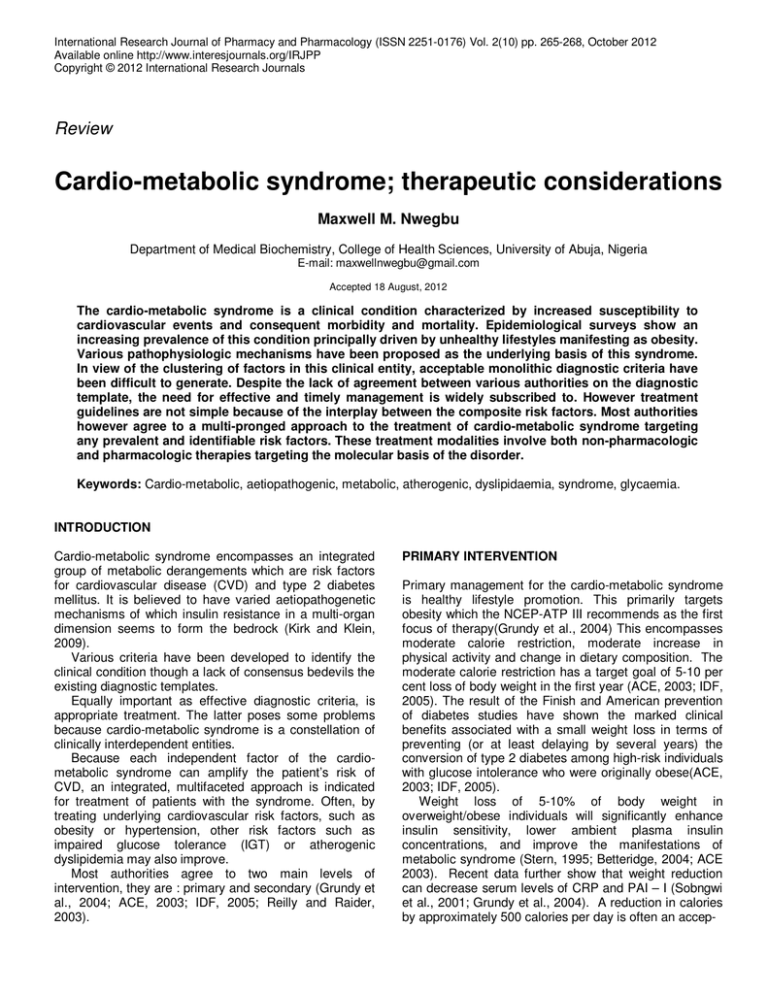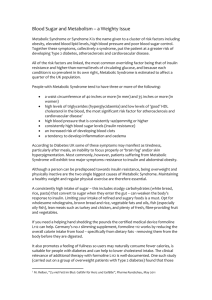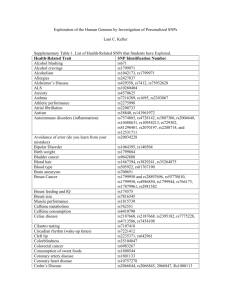Document 14258123
advertisement

International Research Journal of Pharmacy and Pharmacology (ISSN 2251-0176) Vol. 2(10) pp. 265-268, October 2012 Available online http://www.interesjournals.org/IRJPP Copyright © 2012 International Research Journals Review Cardio-metabolic syndrome; therapeutic considerations Maxwell M. Nwegbu Department of Medical Biochemistry, College of Health Sciences, University of Abuja, Nigeria E-mail: maxwellnwegbu@gmail.com Accepted 18 August, 2012 The cardio-metabolic syndrome is a clinical condition characterized by increased susceptibility to cardiovascular events and consequent morbidity and mortality. Epidemiological surveys show an increasing prevalence of this condition principally driven by unhealthy lifestyles manifesting as obesity. Various pathophysiologic mechanisms have been proposed as the underlying basis of this syndrome. In view of the clustering of factors in this clinical entity, acceptable monolithic diagnostic criteria have been difficult to generate. Despite the lack of agreement between various authorities on the diagnostic template, the need for effective and timely management is widely subscribed to. However treatment guidelines are not simple because of the interplay between the composite risk factors. Most authorities however agree to a multi-pronged approach to the treatment of cardio-metabolic syndrome targeting any prevalent and identifiable risk factors. These treatment modalities involve both non-pharmacologic and pharmacologic therapies targeting the molecular basis of the disorder. Keywords: Cardio-metabolic, aetiopathogenic, metabolic, atherogenic, dyslipidaemia, syndrome, glycaemia. INTRODUCTION Cardio-metabolic syndrome encompasses an integrated group of metabolic derangements which are risk factors for cardiovascular disease (CVD) and type 2 diabetes mellitus. It is believed to have varied aetiopathogenetic mechanisms of which insulin resistance in a multi-organ dimension seems to form the bedrock (Kirk and Klein, 2009). Various criteria have been developed to identify the clinical condition though a lack of consensus bedevils the existing diagnostic templates. Equally important as effective diagnostic criteria, is appropriate treatment. The latter poses some problems because cardio-metabolic syndrome is a constellation of clinically interdependent entities. Because each independent factor of the cardiometabolic syndrome can amplify the patient’s risk of CVD, an integrated, multifaceted approach is indicated for treatment of patients with the syndrome. Often, by treating underlying cardiovascular risk factors, such as obesity or hypertension, other risk factors such as impaired glucose tolerance (IGT) or atherogenic dyslipidemia may also improve. Most authorities agree to two main levels of intervention, they are : primary and secondary (Grundy et al., 2004; ACE, 2003; IDF, 2005; Reilly and Raider, 2003). PRIMARY INTERVENTION Primary management for the cardio-metabolic syndrome is healthy lifestyle promotion. This primarily targets obesity which the NCEP-ATP III recommends as the first focus of therapy(Grundy et al., 2004) This encompasses moderate calorie restriction, moderate increase in physical activity and change in dietary composition. The moderate calorie restriction has a target goal of 5-10 per cent loss of body weight in the first year (ACE, 2003; IDF, 2005). The result of the Finish and American prevention of diabetes studies have shown the marked clinical benefits associated with a small weight loss in terms of preventing (or at least delaying by several years) the conversion of type 2 diabetes among high-risk individuals with glucose intolerance who were originally obese(ACE, 2003; IDF, 2005). Weight loss of 5-10% of body weight in overweight/obese individuals will significantly enhance insulin sensitivity, lower ambient plasma insulin concentrations, and improve the manifestations of metabolic syndrome (Stern, 1995; Betteridge, 2004; ACE 2003). Recent data further show that weight reduction can decrease serum levels of CRP and PAI – I (Sobngwi et al., 2001; Grundy et al., 2004). A reduction in calories by approximately 500 calories per day is often an accep- 266 Int. Res. J. Pharm. Pharmacol. table strategy to achieve the goal of an ideal weight (Coughlin et al., 2004; Wilson and Grundy, 2003). Changes also need to be made in dietary compositions although there are no agreed percentages amongst dietetic and obesity specialists (Jonathan, 2003). However, there is consensus on the need for reductions in daily fat intake, especially saturated fat and transunsaturated fatty acids, dietary cholesterol and carbohydrates derived from processed cereals (Coughlin et al., 2004; Praveen and Manoj, 2003). Additionally intake of poly-unsaturated fatty acids (PUFA), and viscous fibre e.g. as in oats, pectin have been shown to be beneficial especially at improving atherogenic dyslipidemia (Praveen and Manoj, 2003). Studies have clearly shown the benefit of PUFA (particularly n = 3) from mainly fish sources in the improvement of cardiometabolic syndrome (Clark, 2001). PUFA is noted to do this on a molecular level through activation of the transcription factor peroxisome proliferators-activated receptor α (PPAR-α) leading to up-regulation and downregulation of lipid oxidation and lipid synthesis genes respectively (Clark, 2001). In other words PUFA function as metabolic fuel re-partitioners. National Cholesterol Education Program; Adult treatment Panel III (NCEP ATP III) recommends fat intake of 25 – 35% of total caloric intake and <300g per day of cholesterol. However the need for an individual approach to dietary advice taking into consideration, the patient’s energy requirements is crucial (Coughlin et al., 2004). An increase in physical activity is of considerable utility and provides two benefits. At the simplest level, any increase in energy expenditure will help insulin resistant individuals maintain or lose weight (ACE, 2003; Jonathan, 2003; Coughlin et al., 2004). Additionally, it will also enhance insulin sensitivity directly with a minimum of 30 – 40 minutes of aerobic exercise four times weekly. Regular exercise apart from increasing insulin sensitivity, also decreases TG levels and reduces morbidity and mortality (Praveen and Manoj, 2003). The combined effect of weight reduction and increased physical activity in significantly decreasing the development of type 2 diabetes in high-risk individuals is also well-documented (ACE, 2003). SECONDARY INTERVENTION In people for whom lifestyle change is not enough, those considered to be high risk for CVD, and given the difficulty and limits of efficacy of lifestyle changes in many individuals, drug therapy may be required to treat the cardio-metabolic syndrome(ACE, 2003; IDF, 2005). While there is a definite need for a treatment that can modulate the underlying mechanisms of the cardiometabolic syndrome as a whole and thereby reduce the impact of all the risk factors and the long term metabolic and vascular consequences, these mechanisms are currently not fully elucidated and specific pharmacological agents are therefore not yet available (IDF, 2005). It is currently necessary instead to treat the individual components of the syndrome in order that a reduction in the individual risk associated with each one will reduce the overall impact on CVD and diabetes risk (Stern, 1995; ACE, 2003; IDF, 2005). Atherogenic dyslipidaemia The primary aims of therapy here are to lower triglycerides, raise HDL.c levels and reduce LDL – c levels. The lowering of triglycerides would lower ApoB and non-HDL cholesterol levels as well (IDF, 2005).Available options to achieve the above aims include the use of fibrates, statins or combination of both. It is also of note that thiazolidinediones primarily used for their effect on tackling insulin resistance, also lower triglycerides levels and raise HDL cholesterol levels (Bloomgarden, 2002). Fibrates which are PPAR alpha agonists, improve all components of atherogenic dyslipidaemia (IDF, 2005). The Veterans Affairs HighDensity Lipoprotein Intervention Trial (VA-HIT) showed reduction in the incidence of major coronary events using fibrates in patients with well-established CHD (Robins et al., 2003). Several clinical studies have confirmed the benefits of statin therapy and its usefulness in achieving ATP III goals (Heart Protection Study Collaborative Group, 2003; Goldberg and Mellies, 1998). Combined statin-fibrate therapies have been shown in clinical studies to doubly improve abnormal lipoprotein pattern (Grundy et al., 2004). However lack of controlled clinical trials and the enhanced side effects in this combination have limited the acceptance of this clinically (Grundy et al., 2004; IDF, 2005). Elevated blood pressure Optimal management of hypertension in the cardiometabolic syndrome through aggressive management may in addition help improve cholesterol levels, and insulin sensitivity. In patient with diabetes, antihypertensive therapy should be introduced at blood pressure>130/>80mmHg which is a lower cut-off than in non-diabetics (IDF, 2005;Bakins and Williams, 2000). According to the sixth Report of the Joint National Committee on Prevention, Detection, Evaluation and Treatment of High Blood Pressure (JNC VI) guidelines, patients with the cardio-metabolic syndrome should be managed differently from patients who do not have the disorder. For example high dose thiazides may be contraindicated in patients who are insulin resistant, because such therapy may exacerbate insulin resistant (Krentz, 1996). In addition beta-blockers and diuretics may not be well tolerated and may confer an increased Nwegbu 267 risk of general side effects and therefore may not be the appropriate first choice for patients with the cardiometabolic syndrome (UKPDS (39), 1998). While a few authorities believe that the risk reduction associated with anti-hypertensive drugs is the result of blood pressure lowering per se and not due to a particular type of drug (IDF, 2003), some major clinical trials have proven otherwise. Studies like the HOPE (Heart Outcomes Prevention Evaluation) trial (Kennedy et al., 2001), Prevention of Events with Angiotensin Converting Enzyme Inhibition (PEACE) study (Pfeffer, 1998), and the TRACE (Trandolapril Cardiac Evaluation) study(Kober, 1995), have shown that ACE inhibitors should be first choice agents in individuals with hypertension associated with cardio-metabolic syndrome. Ramipril which was the ACE inhibitor used in the HOPE trials also showed that ACE inhibitors additionally reduce insulin resistance and ramipril in that study prevented the development of type 2 diabetes mellitus in the study population (Kennedy et al., 2001). Angiotensin receptor blockers (ARBs) could be used in patients unable to tolerate the side effects associated with ACE inhibitors, but are not known to effect an increase in insulin sensitivity and as such may not be appropriate for patients with cardio-metabolic syndrome. Additionally other antihypertensive drugs are also important and should be utilized in combination with ACE inhibitors to achieve the goal of optimal blood pressure control. Insulin resistance Insulin sensitivity can often be improved through the management of obesity, hypertension and dyslipidaemia in the cardio-metabolic syndrome. Improvements in a patient’s weight, blood pressure and lipid profile correlate with improvements in a patient’s glucose level. However when these measures fail to lower blood glucose levels, drugs that directly improve the patient’s insulin sensitivity should be considered. Metformin, a biguanide, has been shown in a subset of the UKPDS to be effective monotherapy for the treatment of obese diabetic patients (UKPDS (33) 1998). Due to its effect on improvement of insulin resistance, triglyceride and LDL-c levels are also decreased (UKPDS(33), 1998). Metformin has also been shown to prevent or delay the development of diabetes mellitus (IDF, 2005), and unlike sulphonylureas does not cause weight gain or hypoglycemia. Sulphonylureas on the other hand, have been shown in some studies to be effective as part of a combination regimen rather than a first line monotherapy as they cause weight gain, a side effect that can exacerbate symptoms of cardio-metabolic syndrome. α -Glucosidase inhibitors like acarbose which act by inhibiting enzymatic digestion of starches in the body, slowing the rate of blood glucose increase can also be used. However this class of drugs is most effective when used in combination with other oral drugs such as metformin or sulphonylureas. Studies have shown that acarbose can prevent glucose toxicity and beta-cell exhaustion, and it should be an essential component of any anti-diabetic regimen in patients with type 2 diabetes mellitus and cardio-metabolic syndrome (Chiasson and Josse, 2002). Thiazolidinediones increase the body’s sensitivity to insulin by activating metabolism and fat synthesis genes. So apart from reducing insulin resistance, thiazolidinediones favourably modify several metabolic risk factors and reverse abnormal arterial responses (Grundy et al., 2004). Recent studies on thiazolidinediones have also demonstrated efficacy in delaying or preventing type 2 diabetes mellitus in patients with impaired glucose tolerance and insulin resistance (Buchanan, 2002; Durbin, 2004). There is a consensus of opinion amongst many that every opportunity should be taken to treat patients with type 2 diabetes mellitus and cardio-metabolic syndrome with insulin sensitizers; metformin and thiazolidinediones. The Diabetes Prevention Programme and some other studies highlighted the need for treatment of individuals with impaired glucose tolerance with insulin sensitizers to prevent or delay the onset of diabetes. As such it has become widely accepted that individuals with cardiometabolic syndrome who have impaired glucose tolerance as a component should be treated with insulin sensitizers (Bloomgarden, 2001; Diabetes Prevention Programme Research Group, 2002). However the issue of individuals with cardio-metabolic syndrome who do not have impaired glucose tolerance receiving insulin sensitizers as therapy is not yet agreed on by various authorities. It is of note that studies on a new class of drugs which interact with both PPAR alpha (α) and gamma (γ) receptors is on. These drugs are envisaged to combine lipid and glycaemic effects. In addition, emerging therapies such as incretin mimetics, dipeptidyl peptidase 1V inhibitors, protein tyrosine phosphatase 1B inhibitors and the endocannabinoid receptor blocking agents, offer potential as future therapies for the cardio-metabolic syndrome (IDF, 2005). Another form of secondary intervention which is recommended for severely obese individuals with cardiometabolic syndrome is surgery. Bariatric operations are generally designed to result in restriction of food passage, nutrient malabsorption or both(Jonathan, 2003). Many procedures have been described but three operations; gastric bypass, vertical banded gastroplasty and gastric banding have produced the best results to date (Coughlin et al., 2004). Compared with other interventions, surgery has produced the longest period of sustained weight loss (Coughlin et al., 2004). The definition of severely obese or morbidly obese individuals who are candidates for bariatric surgery (when other treatments have failed) is variable. However the Swedish 268 Int. Res. J. Pharm. Pharmacol. Obesity Subjects (SOS) Intervention study used an 2 average BMI of 42kg/m , and was noted to have garnered weight losses of 21% and 35% one year after gastric banding and gastric bypass respectively (Jonathan, 2003). Complications,poor patient acceptance and the need for life-long medical monitoring to micronutrient deficiencies e.t.c. has limited generalized application of bariatric surgery. CONCLUSION The management of cardio-metabolic syndrome requires careful assessment of the prevalent risk factors in each individual and subsequent targeted treatment of the identified factors. Treatment targeted at lifestyle modifications remains the primary therapeutic goal. Where there are other confounding factors, additional pharmacotherapy may be needed. It is imperative that early and intensive therapy is instituted in order to prevent the severe complications of this syndrome. REFERENCES American College of Endocrinology (ACE) Position statement (2003). Endocr. Pract.; 9(3):240-51. Bakins GL, Williams M (2000). Preserving renal function in adults with hypertension and diabetes: a consensus approach. National Kidney Foundation Hypertension and Diabetes Executive Committees Working Group. Am. J. Kidney Dis. 36:646-61. Betteridge DJ (2004). The interplay of cardiovascular risk factors in the metabolic syndrome and type 2 diabetes. Eur Heart J. Supplements. 6(G):G3-7. Bloomgarden ZT (2001). Thiazolidinediones, obesity and related topics. Diabetes Care; 24:172-177. Bloomgarden ZT (2002). Obesity, hypertension and insulin resistance. Diabetes. 25:2088-97. Buchanan TA, Xiang AH, Peters RK (2002). Preservation of pancreatic beta-cell function and prevention of type 2 diabetes by pharmacological treatment of insulin resistance in high-risk Hispanic women. Diabetes. 51:2796-803. Chiasson JL, Josse RG (2002). Acarbose for prevention of type 2 diabetes mellitus: the STOP-NIDDM randomized trial. Lancet. 359:2072-7. Coughlin SR, Mawdsley L, Mugarza JA, Calverley PMA, Wilding JPH (2004). Obstructive sleep apnoea is independently associated with an increased prevalence of metabolic syndrome. Eur. Heart. J. 25:73541. Diabetes Prevention Programme Research Group (2002). Reduction in the incidence of type 2 diabetics with lifestyle intervention or metformin. N. Engl. J Med. 346(6):393-403. Durbin RJ (2004). Thiazolidinediones therapy in the prevention/delay of type 2 diabetes in patients with impaired glucose tolerance and insulin resistance. Diabetes, Obesity and Metabolism. 6:280-5. Goldberg RB, Mellies MJ (1998). Cardiovascular events and their reduction with pravastatin in diabetic and glucose intolerant myocardial infarction survivors with average cholesterol levels: subgroup analysis in the Cholesterol and Recurrent Events (CARE) trial. Circulation. 98: 2513-9. Grundy SM, Brewer B, Cleeman JI, Smith SC, Lenfant C (2004). Definition of metabolic syndrome: report of the National Heart, Lung, and Blood Institute/American Heart Association Conference on scientific issues related to definition. Arterioscler Thromb. Vasc. Biol. 24(2):e13_e18. Heart Protection Study Collaborative Group (2005). MRC/BHF Heart Protection Study of cholesterol lowering with simvastatin in 5963 people with diabetes; a randomized placebo-controlled trial. Lancet. 361:2005-2016. International Diabetes Federation (2005). The IDF consensus worldwide definition of the metabolic syndrome. Brussels. Jonathan QP (2003). Obesity. Medscape: Web MD scientific American Medicine. Kennedy J, Mogensen CE, Ball SG (2001). What is the relevance of the HOPE Study in general practice? Int. J. Clin. Pract. 55:449-57. Kirk EP, Klein S (2009). Pathogenesis and pathophysiology of the cardiometabolic syndrome. J. Clin. Hypertension. 11(12):761-765 Krentz AJ (1996). Insulin resistance. Brit. Med. J. 313:1385-9. Kober L, Torp-Pedersen C, Carlsen JE (1995). A clinical trial of the angiotensin- converting enzyme inhibitor trandolapril in patients with left ventricular dysfunction after myocardial infarction. Trandolapril Cardiac Evaluation (TRACE) Study Group. N. Engl. J. Med. 333:1670-6 Pfeffer MA, Domanski M, Rosenberg Y (1998). Prevention of events with angiotensin-converting enzyme inhibitors (the PEACE study design). Am. J. Cardiol. 82:25H-30. Praveen S, Manoj S (2003). Metabolic syndrome: its pathogenesis and management. Indian Acad. Clin. Med.; 4:275-81. Reilly PM, Raider DJ (2003). The metabolic syndrome: more than the sum of its parts? Circulation 108(13):1546-55. Robins SJ, Rubins HB, Faas FH (2003). Insulin resistance and cardiovascular events with low HDL cholesterol. The Veteran Affairs HDL Intervention Trial (VA-HIT). Diabetes Care. 26(5):1513-17. Sobngwi E, Mauvais-Jarvis F, Vexiau P, Mbaya J, Gautier J (2001). Diabetes in Africans. Part 1: epidemiology and clinical specificities. Diabet Metab. 27:628-34 Stern MP (1995). Diabetes and cardiovascular disease; the common soil hypothesis. Diabetes. 44:369-81. UK Prospective Diabetes Study Group (1998). Efficacy of atenolol and captopril in reducing risk of macrovascular complications in type 2 diabetes: UKPDS 39. BMJ. 317:713-20. Wilson PWF, Grundy SM (2003). The metabolic syndrome: Practical Guide to Origins and Treatment: Part. I. Circulation. 108:1422-5.






